Radar Target Localization with Multipath Exploitation in Dense Clutter Environments
Abstract
1. Introduction
- Derivation of the likelihood of cluttered multipath measurement with respect to the reference multipath parameters predicted by the ray-tracing technique and the approximation of multipath likelihood;
- Proposal of an accurate target localization method based on NLS optimizations of associated multipath measurements;
- Simulation results in various conditions validating the robustness and performance of the proposed method.
2. Model
2.1. Multipath Propagation Model via Ray-Tracing
2.2. Measurement Model
3. Method
3.1. Likelihood Function with Multi-Measurement
3.2. Approximation of Likelihood
3.3. Target Localization Algorithm
4. Simulation Results
5. Conclusions
Author Contributions
Funding
Institutional Review Board Statement
Informed Consent Statement
Data Availability Statement
Conflicts of Interest
References
- Zekavat, S.; Buehrer, R.M. Source Localization: Algorithms and Analysis. In Handbook of Position Location: Theory, Practice, and Advances; Wiley-IEEE Press: Piscataway, NJ, USA, 2012; pp. 25–66. [Google Scholar]
- Zou, Y.; Fan, J.; Wu, L.; Liu, H. Fixed Point Iteration Based Algorithm for Asynchronous TOA-Based Source Localization. Sensors 2022, 22, 6871. [Google Scholar] [CrossRef] [PubMed]
- Abu-Shaban, Z.; Zhou, X.; Abhayapala, T.D. A Novel TOA-Based Mobile Localization Technique Under Mixed LOS/NLOS Conditions for Cellular Networks. IEEE Trans. Veh. Technol. 2016, 65, 8841–8853. [Google Scholar] [CrossRef]
- Wielandt, S.; De Strycker, L. Indoor multipath assisted angle of arrival localization. Sensors 2017, 17, 2522. [Google Scholar] [CrossRef]
- Li, C.; Zhen, J.; Chang, K.; Xu, A.; Zhu, H.; Wu, J. An Indoor Positioning and Tracking Algorithm Based on Angle-of-Arrival Using a Dual-Channel Array Antenna. Remote Sens. 2021, 13, 4301. [Google Scholar] [CrossRef]
- Zhu, K.; Wei, Y.; Xu, R. TOA-based localization error modeling of distributed MIMO radar for positioning accuracy enhancement. In Proceedings of the 2016 CIE International Conference on Radar (RADAR 2016), Guangzhou, China, 10–13 October 2016. [Google Scholar] [CrossRef]
- Chen, Z.; Xu, A.; Sui, X.; Wang, C.; Wang, S.; Gao, J.; Shi, Z. Improved-UWB/LiDAR-SLAM Tightly Coupled Positioning System with NLOS Identification Using a LiDAR Point Cloud in GNSS-Denied Environments. Remote Sens. 2022, 14, 1380. [Google Scholar] [CrossRef]
- Cong, L.; Zhuang, W. Nonline-of-sight error mitigation in mobile location. IEEE Trans. Wirel. Commun. 2005, 4, 560–573. [Google Scholar] [CrossRef]
- Sen, S.; Nehorai, A. Slow-time multi-frequency radar for target detection in multipath scenarios. In Proceedings of the ICASSP, IEEE International Conference on Acoustics, Speech and Signal Processing, Dallas, TX, USA, 14–19 March 2010; pp. 2582–2585. [Google Scholar] [CrossRef]
- Sen, S.; Nehorai, A. Sparsity-based multi-target tracking using OFDM radar. IEEE Trans. Signal Process. 2011, 59, 1902–1906. [Google Scholar] [CrossRef]
- Sen, S.; Nehorai, A. Adaptive OFDM radar for target detection in multipath scenarios. IEEE Trans. Signal Process. 2011, 59, 78–90. [Google Scholar] [CrossRef]
- Sen, S.; Tang, G.; Nehorai, A. Designing OFDM radar waveform for target detection using multi-objective optimization. In Advances in Heuristic Signal Processing and Applications; Springer: Berlin/Heidelberg, Germany, 2013; pp. 35–61. [Google Scholar] [CrossRef]
- Romeo, K.; Bar-Shalom, Y.; Willett, P. Fusion of multipath data with ML-PMHT for very low SNR track detection in an OTHR. J. Adv. Inf. Fusion 2015, 10, 113–124. [Google Scholar]
- Romeo, K.; Bar-Shalom, Y.; Willett, P. Low SNR track detection with OTHR based on a refraction model. In Proceedings of the 2016 IEEE Radar Conference (RadarConf 2016), Philadelphia, PA, USA, 2–6 May 2016; pp. 2–5. [Google Scholar] [CrossRef]
- Lan, H.; Liang, Y.; Pan, Q.; Yang, F.; Guan, C. An EM algorithm for multipath state estimation in OTHR target tracking. IEEE Trans. Signal Process. 2014, 62, 2814–2826. [Google Scholar] [CrossRef]
- Yang, F.; Wang, Y.; Liang, Y.; Pan, Q. A multipath Gaussian mixture PHD filter algorithm for OTHR multi-target tracking. In Proceedings of the 32nd Chinese Control Conference (CCC), Xi’an, China, 26–28 July 2013; pp. 4607–4612. [Google Scholar]
- Pulford, G.W.; Evans, R.J. A multipath data association tracker for over-the-horizon radar. IEEE Trans. Aerosp. Electron. Syst. 1998, 34, 1165–1183. [Google Scholar] [CrossRef]
- Zhang, Y.; Xia, T. In-Wall Clutter Suppression Based on Low-Rank and Sparse Representation for Through-the-Wall Radar. IEEE Geosci. Remote Sens. Lett. 2016, 13, 671–675. [Google Scholar] [CrossRef]
- Qu, L.; Fang, Z.; Yang, T.; Sun, Y.; Zhang, L. Sparse Recovery Method for Estimation of Wall Parameters in Through-the-Wall Radar. In Proceedings of the IGARSS 2019—2019 IEEE International Geoscience and Remote Sensing Symposium, Yokohama, Japan, 28 July–2 August 2019; pp. 3558–3561. [Google Scholar] [CrossRef]
- Yektakhah, B.; Sarabandi, K. A Method for Detection of Flat Walls in Through-the-Wall SAR Imaging. IEEE Geosci. Remote Sens. Lett. 2021, 18, 2102–2106. [Google Scholar] [CrossRef]
- Yong Kang, O.; Long, C. A Robust Indoor Mobile Localization Algorithm for Wireless Sensor Network in Mixed LOS/NLOS Environments. J. Sens. 2020, 2020, 8854389. [Google Scholar] [CrossRef]
- Al-Qudsi, B.; Joram, N.; El-Shennawy, M.; Ellinger, F. Scalable indoor positioning system with multi-band FMCW. IET Radar Sonar Navig. 2018, 12, 46–55. [Google Scholar] [CrossRef]
- Setlur, P.; Smith, G.E.; Ahmad, F.; Amin, M.G. Target localization with a single-antenna monostatic radar via multipath exploitation. Radar Sens. Technol. XV 2011, 8021, 80210J. [Google Scholar] [CrossRef]
- Setlur, P.; Devroye, N. Bayesian and Cramér-Rao bounds for single sensor target localization via multipath exploitation. In Proceedings of the ICASSP, IEEE International Conference on Acoustics, Speech and Signal Processing, Vancouver, BC, Canada, 26–31 May 2013; pp. 5845–5849. [Google Scholar] [CrossRef]
- Muqaibel, A.H.; Amin, M.G.; Ahmad, F. Target localization with a single antenna via directional multipath exploitation. Int. J. Antennas Propag. 2015, 2015, 510720. [Google Scholar] [CrossRef]
- Liu, C.; Xiang, H.; Li, F.; Shi, H.; Wang, W.; Gao, W.; Zhang, J.; Ning, Y. Study on GNSS-R multi-target detection and location method based on consistency checking. IET Radar Sonar Navig. 2021, 15, 605–617. [Google Scholar] [CrossRef]
- Kamann, A.; Held, P.; Perras, F.; Zaumseil, P.; Brandmeier, T.; Schwarz, U.T. Automotive Radar Multipath Propagation in Uncertain Environments. In Proceedings of the 2018 21st IEEE Conference on Intelligent Transportation Systems (ITSC), Maui, HI, USA, 4–7 November 2018; pp. 859–864. [Google Scholar] [CrossRef]
- Li, S.; Guo, S.; Chen, J.; Yang, X.; Fan, S.; Jia, C.; Cui, G.; Yang, H. Multiple Targets Localization behind L-Shaped Corner via UWB Radar. IEEE Trans. Veh. Technol. 2021, 70, 3087–3100. [Google Scholar] [CrossRef]
- Zhao, Q.; Cui, G.; Guo, S.; Yi, W.; Kong, L.; Yang, X. Millimeter Wave Radar Detection of Moving Targets behind a Corner. In Proceedings of the 2018 21st International Conference on Information Fusion (FUSION), Cambridge, UK, 10–13 July 2018; pp. 2042–2046. [Google Scholar] [CrossRef]
- Yang, X.; Member, S.; Fan, S.; Guo, S.; Li, S.; Cui, G.; Zhang, W.; Member, S.; Fan, S.; Guo, S.; et al. NLOS target localization behind an L-Shaped corner with an L-Band UWB radar. IEEE Access 2020, 8, 31270–31286. [Google Scholar] [CrossRef]
- Scheiner, N.; Kraus, F.; Wei, F.; Phan, B.; Mannan, F.; Appenrodt, N.; Ritter, W.; DIckmann, J.; DIetmayer, K.; Sick, B.; et al. Seeing around Street Corners: Non-Line-of-Sight Detection and Tracking In-the-Wild Using Doppler Radar. In Proceedings of the 2020 IEEE/CVF Conference on Computer Vision and Pattern Recognition (CVPR), Seattle, WA, USA, 13–19 June 2020; pp. 2065–2074. [Google Scholar] [CrossRef]
- Kraus, F.; Scheiner, N.; Ritter, W.; Dietmayer, K. Using Machine Learning to Detect Ghost Images in Automotive Radar. In Proceedings of the 2020 IEEE 23rd International Conference on Intelligent Transportation Systems (ITSC), Rhodes, Greece, 20–23 September 2020. [Google Scholar] [CrossRef]
- Chandran, S.; Jayasuriya, S. Adaptive lighting for data-driven non-line-of-sight 3D localization and object identification. In Proceedings of the 30th British Machine Vision Conference 2019, BMVC 2019, Cardiff, UK, 9–12 September 2019. [Google Scholar]
- Xiong, L.; Miao, H.; Ai, B.; Juhana, T.; Kurniawan, A.; Sonkki, M. Channel characteristics of high-speed railway station based on ray-tracing simulation at 5G mmWave band. Int. J. Antennas Propag. 2019, 2019, 3137583. [Google Scholar] [CrossRef]
- Eid, A.H.; Abuelenin, S.M.; Soliman, H.Y. Using Geometric Algebra for Formulating Electromagnetic Propagation Ray-Tracing Preprocessing. In Recent Advances in Engineering Mathematics and Physics; Springer: Cham, Switzerland, 2020; pp. 223–230. [Google Scholar] [CrossRef]
- Degen, C.; Govaers, F.; Koch, W. Emitter localization under multipath propagation using a likelihood function decomposition that is linear in target space. In Proceedings of the FUSION 2014—17th International Conference on Information Fusion, Salamanca, Spain, 7–10 July 2014; pp. 1–8. [Google Scholar]
- Cheraly, A.; Rabaste, O.; Pétex, J.F.F.; Phan, H.K.K.; Colin-Koeniguer, E.; Poullin, D.; Cheraly. Around-the-corner radar: Detection of a human being in non-line of sight. IET Radar Sonar Navig. 2015, 9, 660–668. [Google Scholar] [CrossRef]
- Johansson, T.; Andersson, Å.; Gustafsson, M.; Nilsson, S. Positioning of moving non-line-of-sight targets behind a corner. In Proceedings of the 2016 13th European Radar Conference (EuRAD), London, UK, 5–7 October 2016; pp. 181–184. [Google Scholar]
- Zaidi, M.; Bouazzi, I.; Usman, M.; Mohammed Shamim, M.Z.; Singh, N.; Gunjan, V.K. Cooperative Scheme ToA-RSSI and Variable Anchor Positions for Sensors Localization in 2D Environments. Complexity 2022, 2022, 5069254. [Google Scholar] [CrossRef]
- de Sousa, M.N.; Thomä, R.S. Enhancement of localization systems in nlos urban scenario with multipath ray tracing fingerprints and machine learning. Sensors 2018, 18, 4073. [Google Scholar] [CrossRef]
- Salski, B.; Czekala, P.; Cuper, J.; Kopyt, P.; Jeon, H.; Yang, W. Electromagnetic Modeling of Radiowave Propagation and Scattering From Targets in the Atmosphere With a Ray-Tracing Technique. IEEE Trans. Antennas Propag. 2021, 69, 1588–1595. [Google Scholar] [CrossRef]
- Remcom. Wireless EM Propagation Software-Wireless Insite. 2022. Available online: https://www.remcom.com/wireless-insite-em-propagation-software (accessed on 18 December 2022).
- Algeier, V.; Demissie, B.; Koch, W.; Thoma, R. Track initiation for blind mobile terminal position tracking using multipath propagation. In Proceedings of the 2008 11th International Conference on Information Fusion, Cologne, Germany, 30 June–3 July 2008; pp. 1–7. [Google Scholar]
- Mahler, R.P. Advances in Statistical Multisource-Multitarget Information Fusion; Artech House: London, UK, 2014. [Google Scholar]
- Du, H.; Fan, C.; Cao, C.; Chen, Z.; Huang, X. NLOS target localization behind an L-shaped corner based on grid matching. IET Conf. Publ. 2020, 2020, 1066–1071. [Google Scholar] [CrossRef]

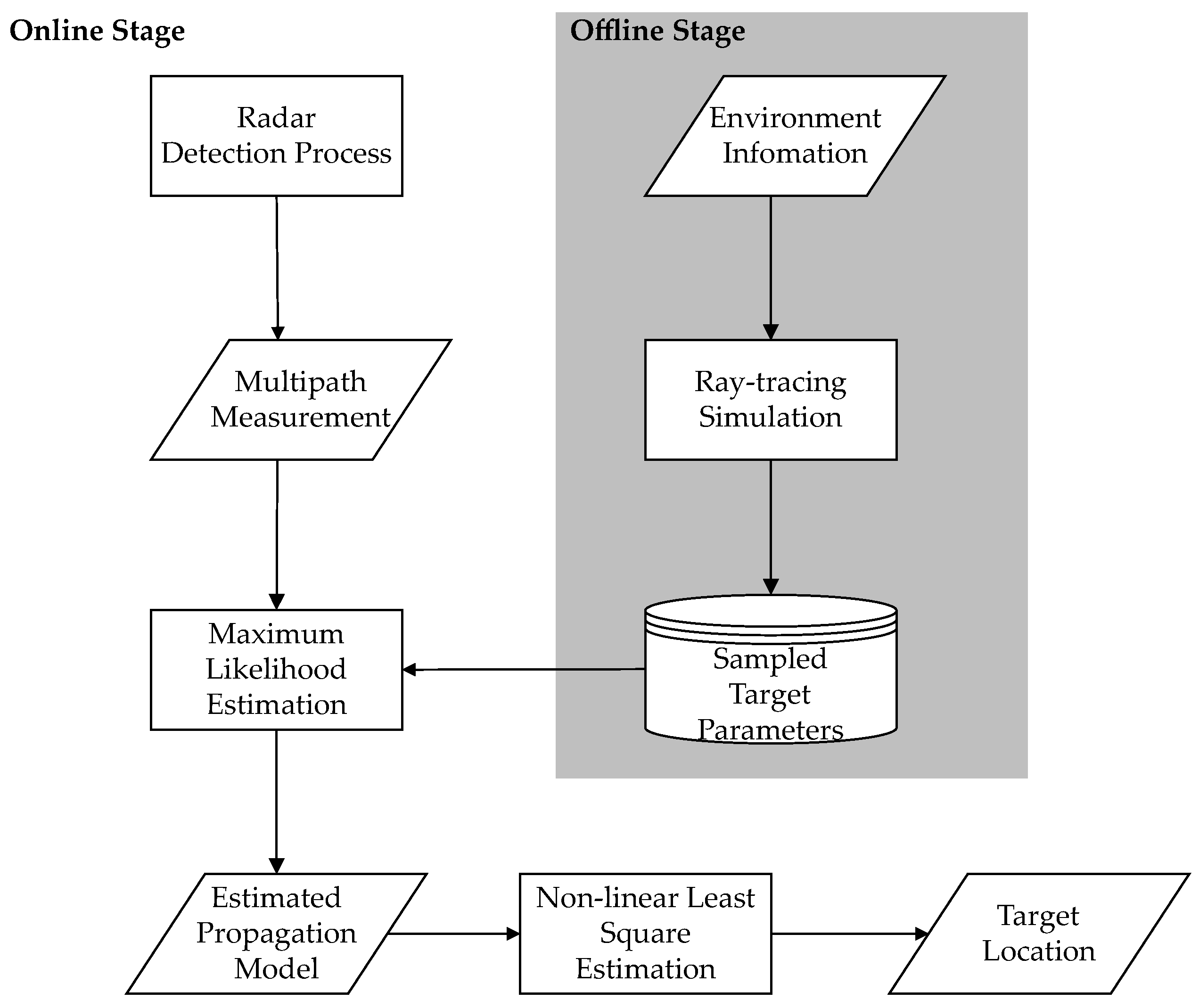

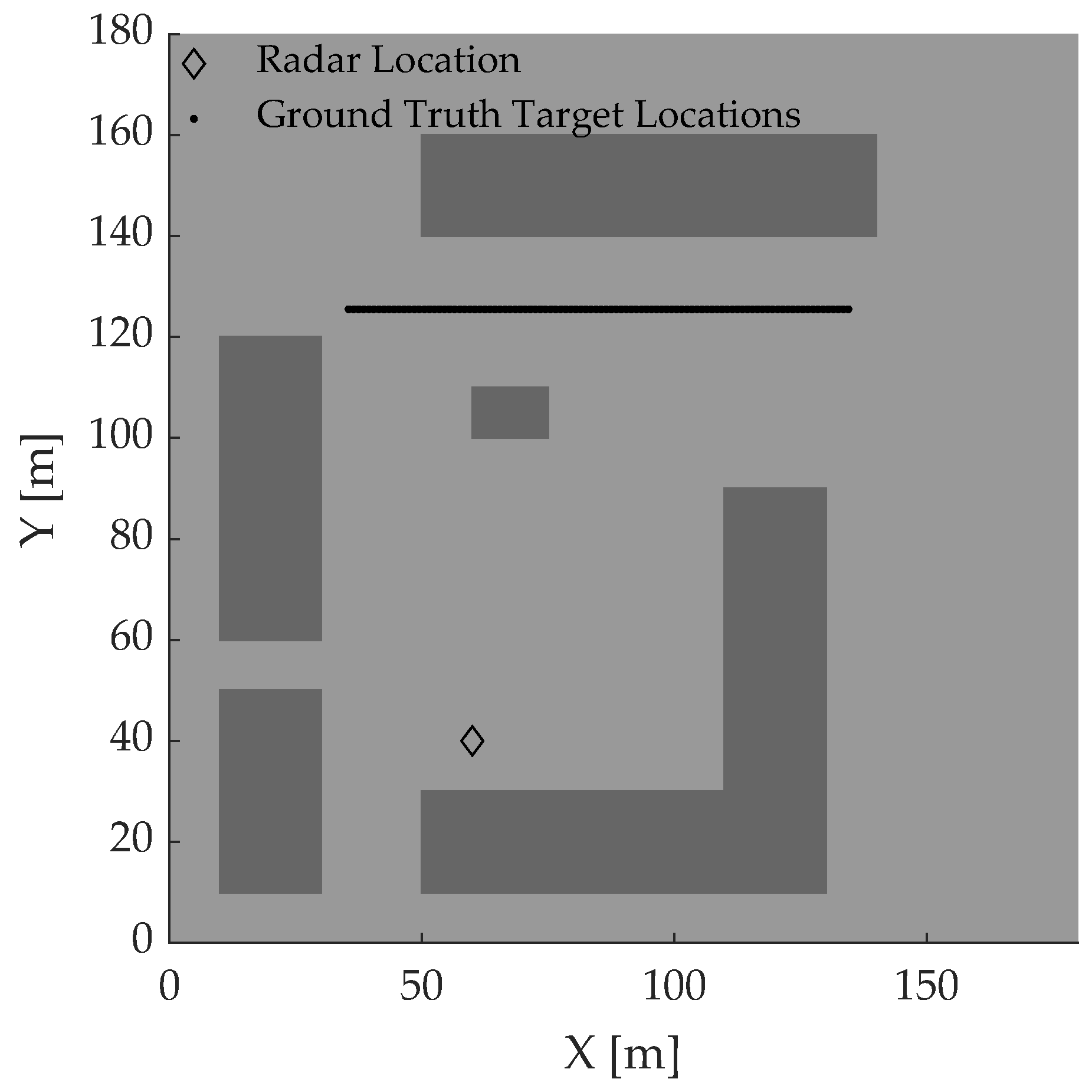
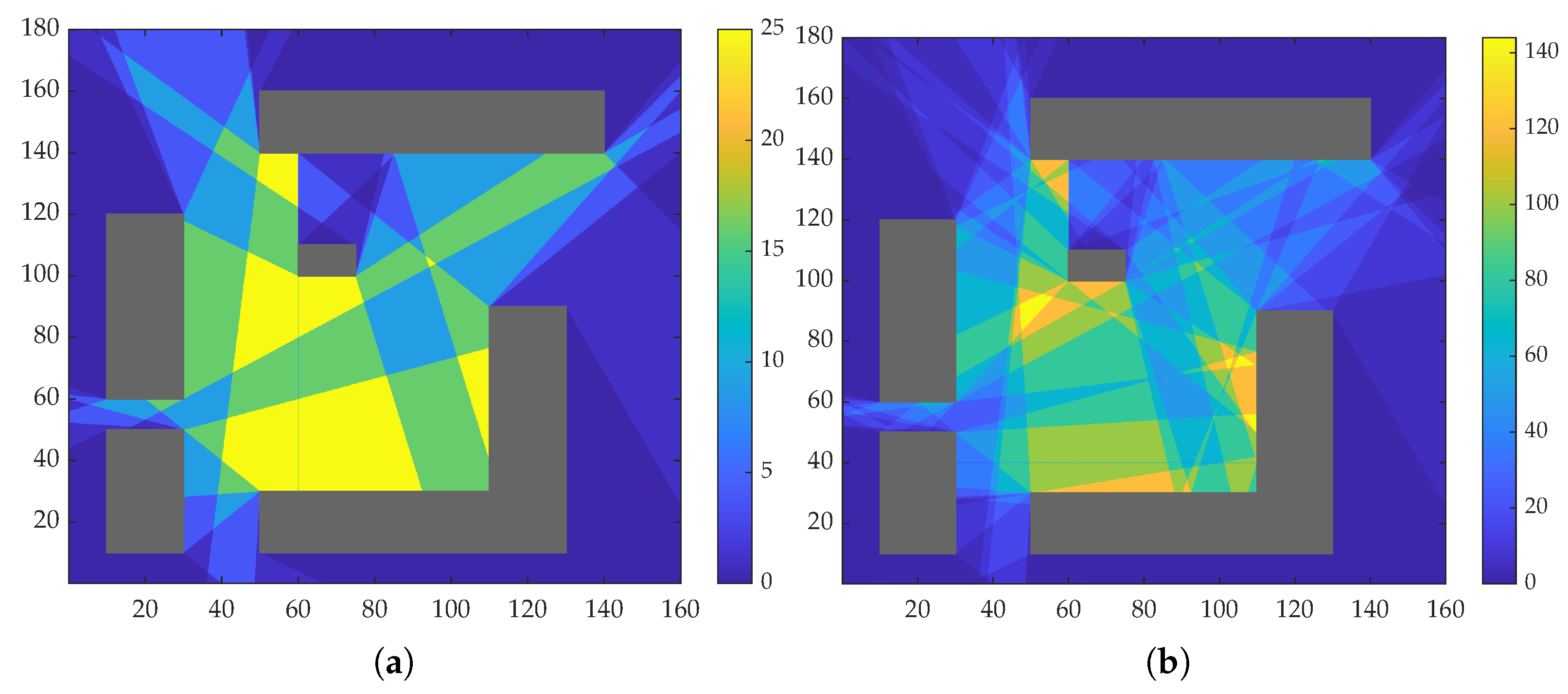
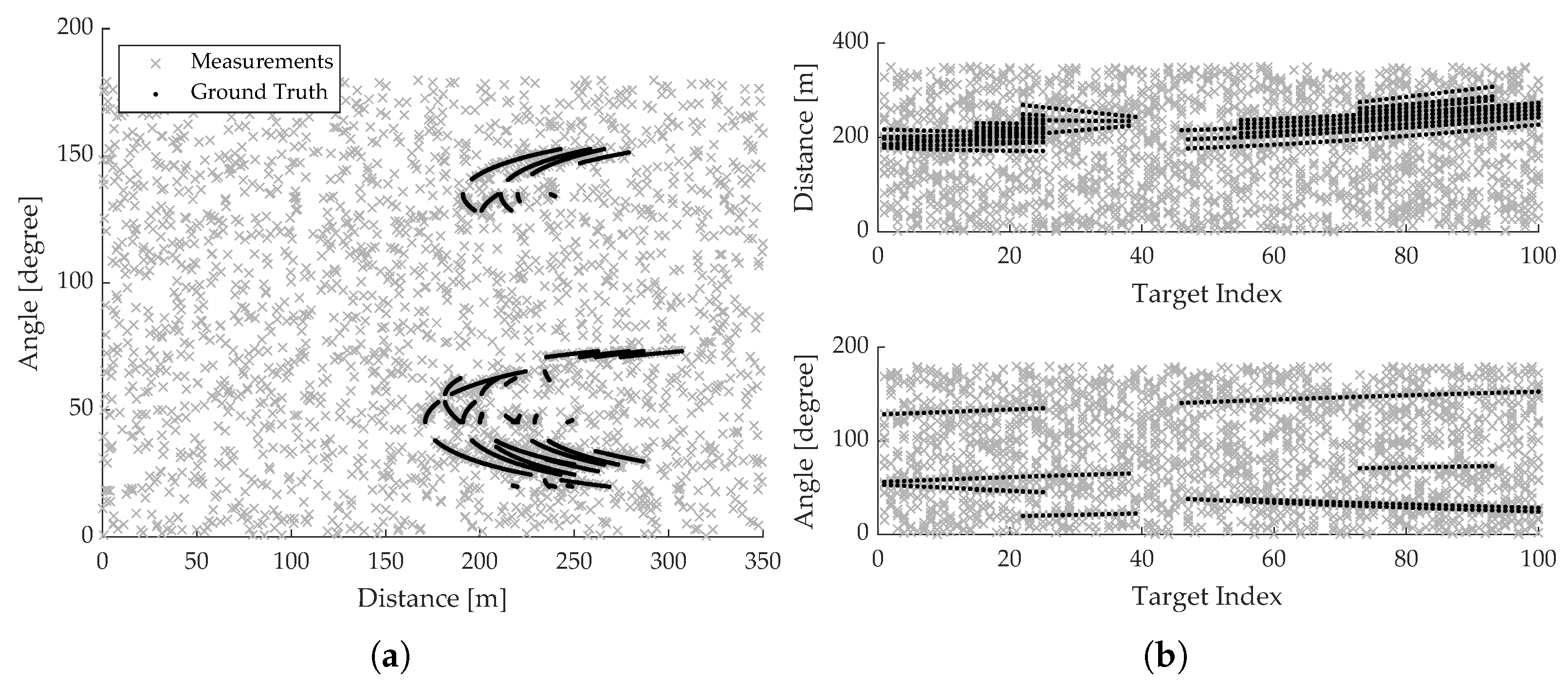
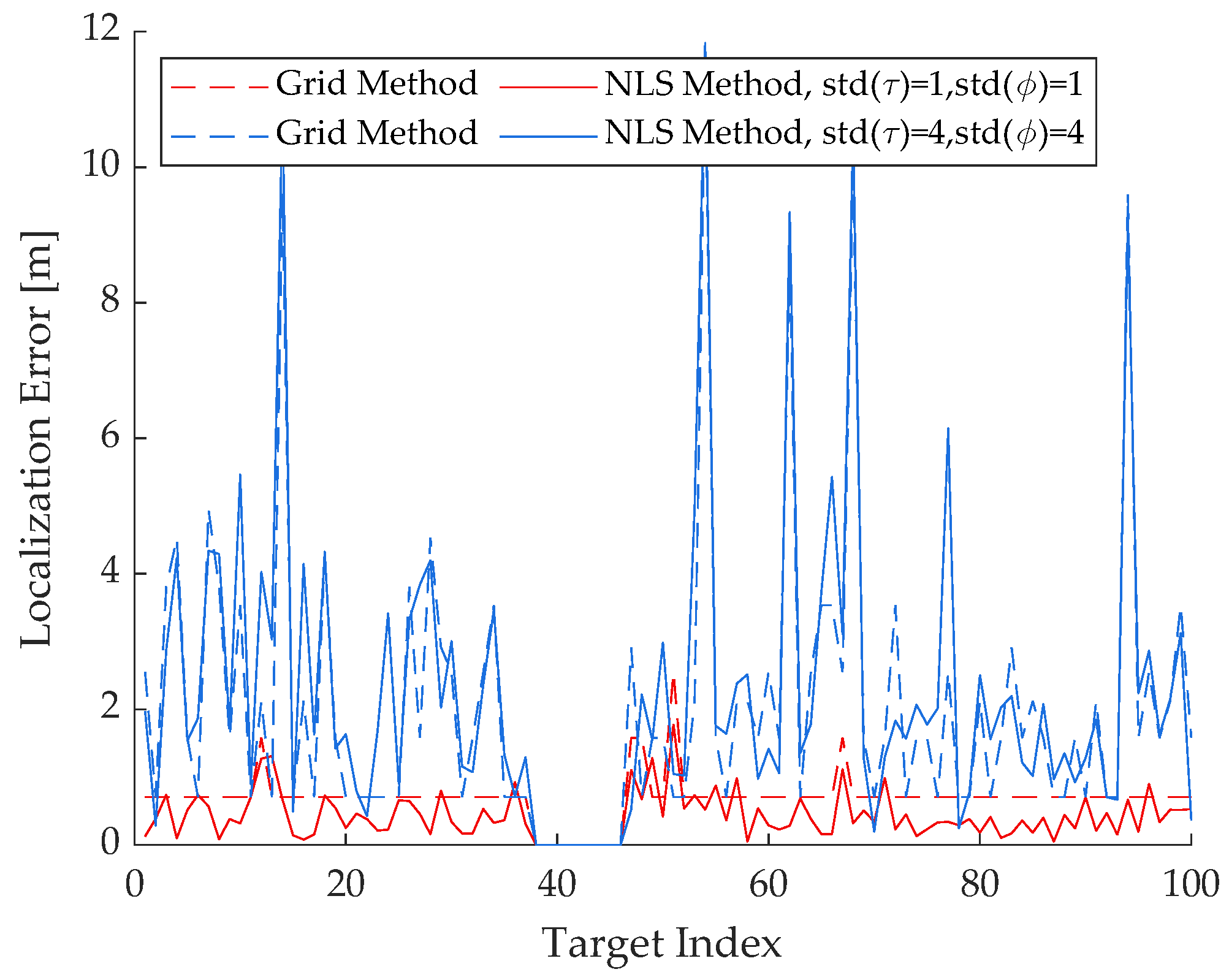
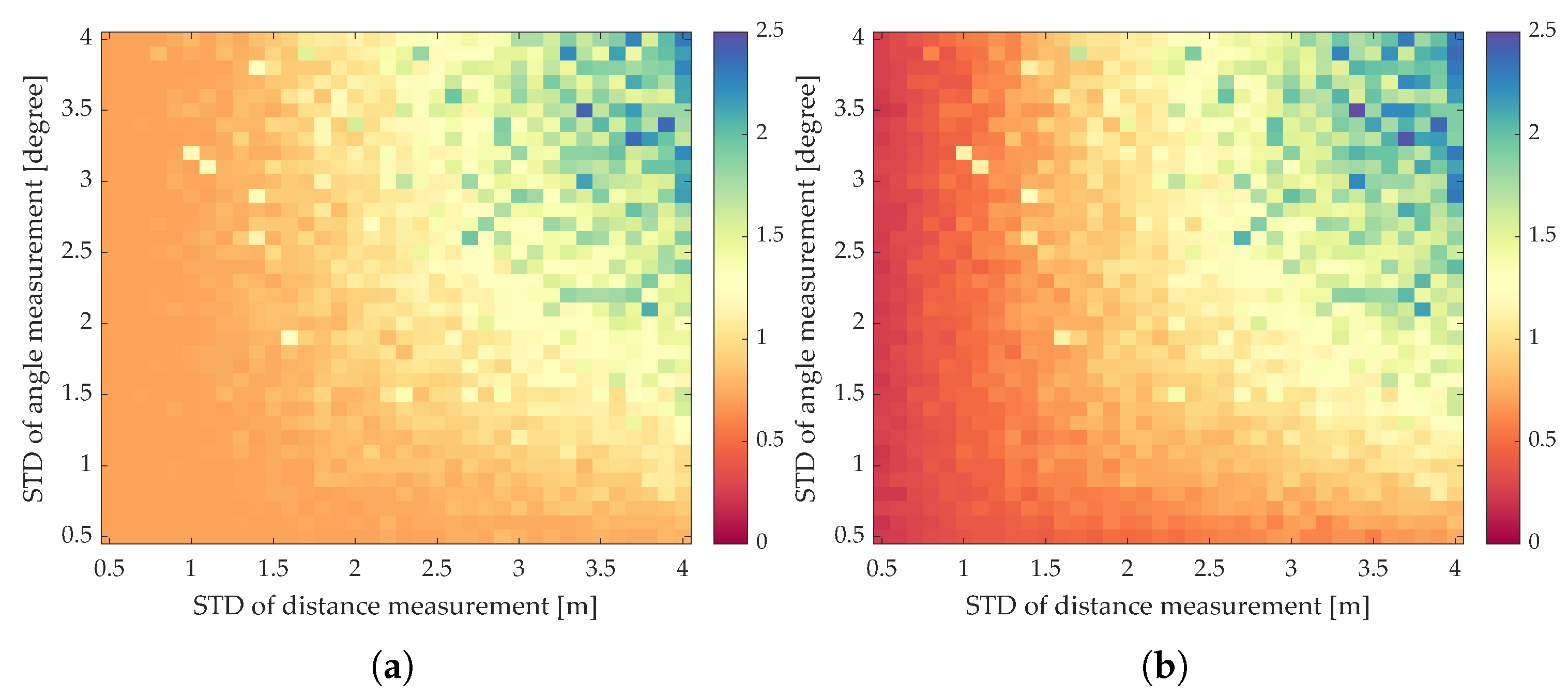
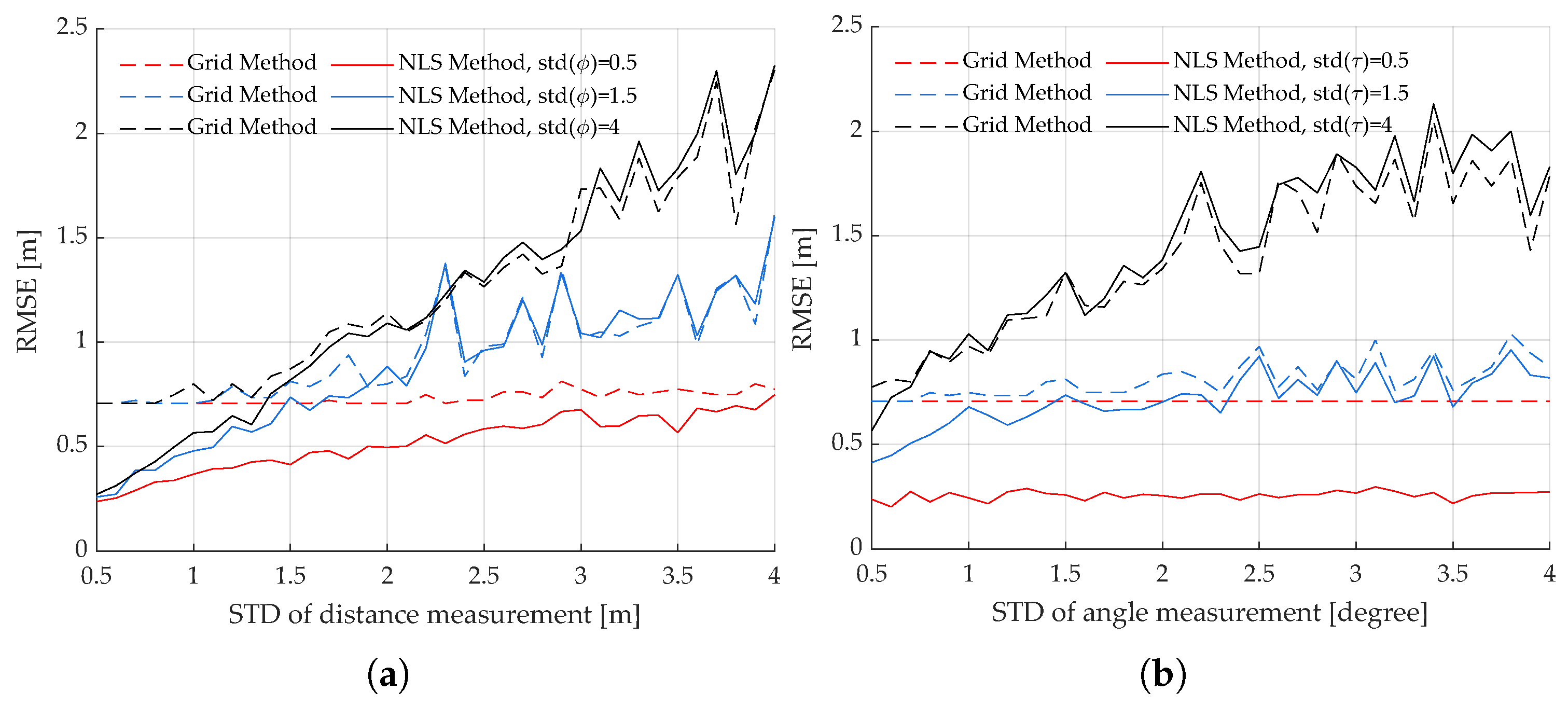

| Proposed Algorithm | Referenced Algorithm | |||
|---|---|---|---|---|
| std() = 0.5 | std() = 1 | std() = 0.5 | std() = 1 | |
| RMSE with no clutter (m) | 0.2247 | 0.3294 | 1.3969 | 6.3886 |
| RMSE with dense clutter (m) | 0.2370 | 0.3676 | 26.9842 | 40.3755 |
Disclaimer/Publisher’s Note: The statements, opinions and data contained in all publications are solely those of the individual author(s) and contributor(s) and not of MDPI and/or the editor(s). MDPI and/or the editor(s) disclaim responsibility for any injury to people or property resulting from any ideas, methods, instructions or products referred to in the content. |
© 2023 by the authors. Licensee MDPI, Basel, Switzerland. This article is an open access article distributed under the terms and conditions of the Creative Commons Attribution (CC BY) license (https://creativecommons.org/licenses/by/4.0/).
Share and Cite
Ding, R.; Wang, Z.; Jiang, L.; Zheng, S. Radar Target Localization with Multipath Exploitation in Dense Clutter Environments. Appl. Sci. 2023, 13, 2032. https://doi.org/10.3390/app13042032
Ding R, Wang Z, Jiang L, Zheng S. Radar Target Localization with Multipath Exploitation in Dense Clutter Environments. Applied Sciences. 2023; 13(4):2032. https://doi.org/10.3390/app13042032
Chicago/Turabian StyleDing, Rui, Zhuang Wang, Libing Jiang, and Shuyu Zheng. 2023. "Radar Target Localization with Multipath Exploitation in Dense Clutter Environments" Applied Sciences 13, no. 4: 2032. https://doi.org/10.3390/app13042032
APA StyleDing, R., Wang, Z., Jiang, L., & Zheng, S. (2023). Radar Target Localization with Multipath Exploitation in Dense Clutter Environments. Applied Sciences, 13(4), 2032. https://doi.org/10.3390/app13042032









